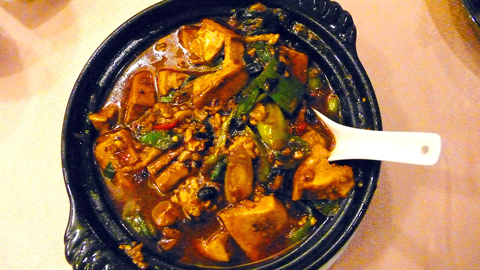Just about everyone who has been to a Chinese restaurant in North America has heard of General Tso’s chicken. But few people know the inventor of the sweet-and-sour deep-fried Hunan dish is Peng Chang-kuei (彭長貴), who opened Peng Yuan in Taipei in 1980 after running a successful restaurant business frequented by celebrities like Henry Kissinger in New York City during the 1970s.
According to the restaurant’s Web site, Peng was a favorite pupil of famed early 20th-century Chinese chef Cao Jing-chen (曹藎臣). After fleeing with Chiang Kai-shek’s (蔣介石) forces to Taiwan, Peng took up the role as the chef for national banquets. It was during this period when the legendary culinary artist started inventing recipes by modifying traditional Hunan dishes, including that of General Tso’s chicken.
It is said that many of the Hunan dishes served at restaurants in Taiwan are adaptations of Peng’s recipes.

PHOTO: HO YI, TAIPEI TIMES
Now a restaurant empire with seven locations in Taiwan that is run by Peng’s eldest son, Peng Yuan is where gourmands go to revisit the master’s oeuvre. This reviewer visited the flagship store on Linsen North Road, which has a second floor that can be used for wedding banquets and a third floor that is partitioned into rooms which seat around six tables of diners.
Renamed chicken a la viceroy (左宗棠雞, NT$280), Peng’s General Tso’s chicken is by no means the sweet variation usually found at Chinese restaurants in the US. Seasoned with chili and soy sauce, the dish doesn’t go overboard in spicing up the boneless chicken drumstick meat, which is tender on the inside and crispy on the outside.
Peng is also credited with inventing what has now become another culinary classic — fu kuei shuang fang (富貴雙方, NT$90 per tiny slice). Think of the dish as a Chinese sandwich filled with roasted bean curd slices (烤素方) and Chinese honey-glazed ham. The ham has just the right amount of fat to give the dish a juicy taste without seeming greasy, while the roasted bean curd is crunchy. Each bite is an explosion of tastes and textures.
Unlike fu kuei shuang fang, which was concocted for national banquets, Peng’s bean curd (彭家豆腐, NT$240) is a meal that the master created for his own lunch. Stewed with fermented soybeans, garlic and pork, the simple dish eloquently exemplifies the typical Hunan taste that is salty and spicy.
Other Hunan specialties include minced shrimp with lettuce (生菜蝦鬆, NT$480), shredded lamb tripe with yellow leeks (韭黃羊肚絲, NT$360) and the steamed assorted preserved meats (蒸腊味合, NT$480), a generous plate of preserved pork, fish and duck.
— HO YI

April 14 to April 20 In March 1947, Sising Katadrepan urged the government to drop the “high mountain people” (高山族) designation for Indigenous Taiwanese and refer to them as “Taiwan people” (台灣族). He considered the term derogatory, arguing that it made them sound like animals. The Taiwan Provincial Government agreed to stop using the term, stating that Indigenous Taiwanese suffered all sorts of discrimination and oppression under the Japanese and were forced to live in the mountains as outsiders to society. Now, under the new regime, they would be seen as equals, thus they should be henceforth

Last week, the the National Immigration Agency (NIA) told the legislature that more than 10,000 naturalized Taiwanese citizens from the People’s Republic of China (PRC) risked having their citizenship revoked if they failed to provide proof that they had renounced their Chinese household registration within the next three months. Renunciation is required under the Act Governing Relations Between the People of the Taiwan Area and the Mainland Area (臺灣地區與大陸地區人民關係條例), as amended in 2004, though it was only a legal requirement after 2000. Prior to that, it had been only an administrative requirement since the Nationality Act (國籍法) was established in

Three big changes have transformed the landscape of Taiwan’s local patronage factions: Increasing Democratic Progressive Party (DPP) involvement, rising new factions and the Chinese Nationalist Party’s (KMT) significantly weakened control. GREEN FACTIONS It is said that “south of the Zhuoshui River (濁水溪), there is no blue-green divide,” meaning that from Yunlin County south there is no difference between KMT and DPP politicians. This is not always true, but there is more than a grain of truth to it. Traditionally, DPP factions are viewed as national entities, with their primary function to secure plum positions in the party and government. This is not unusual

US President Donald Trump’s bid to take back control of the Panama Canal has put his counterpart Jose Raul Mulino in a difficult position and revived fears in the Central American country that US military bases will return. After Trump vowed to reclaim the interoceanic waterway from Chinese influence, US Defense Secretary Pete Hegseth signed an agreement with the Mulino administration last week for the US to deploy troops in areas adjacent to the canal. For more than two decades, after handing over control of the strategically vital waterway to Panama in 1999 and dismantling the bases that protected it, Washington has